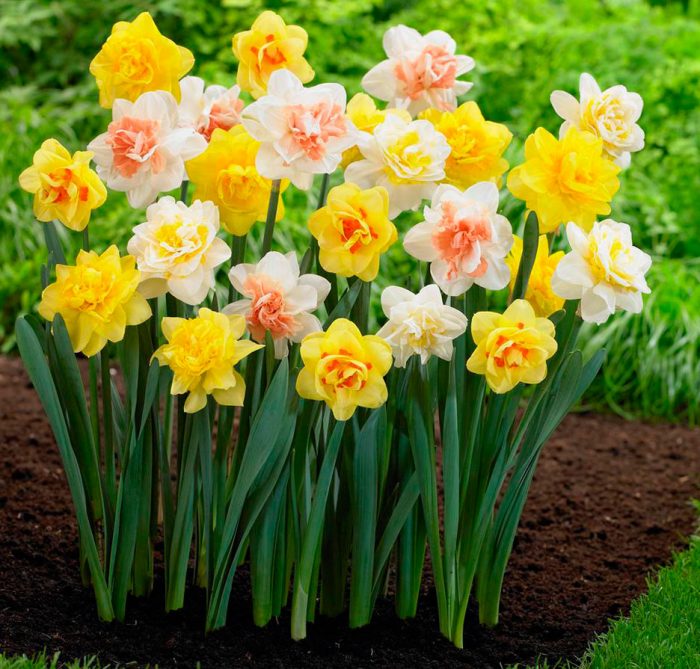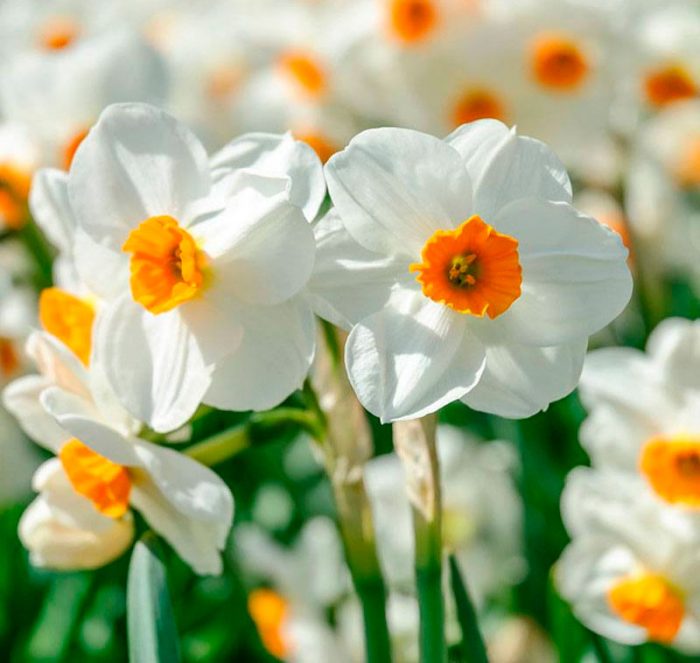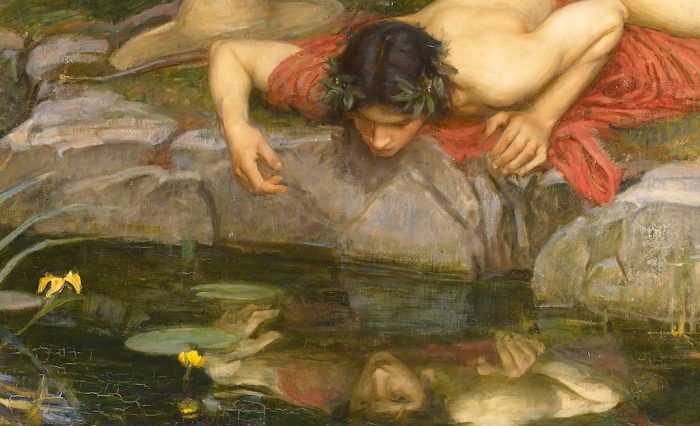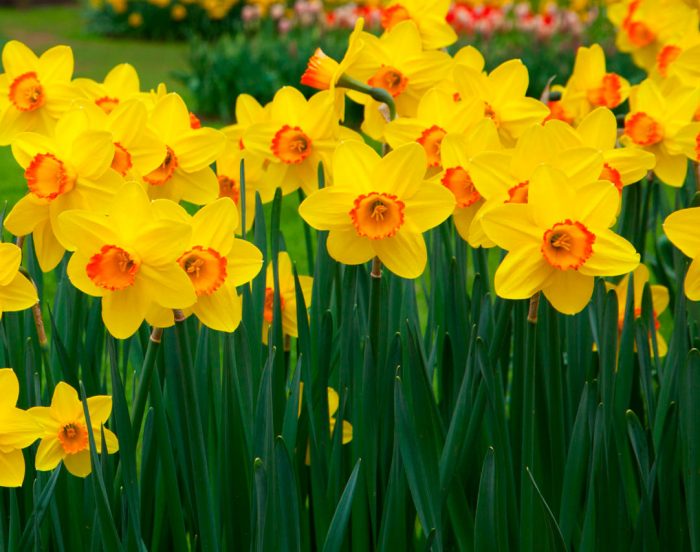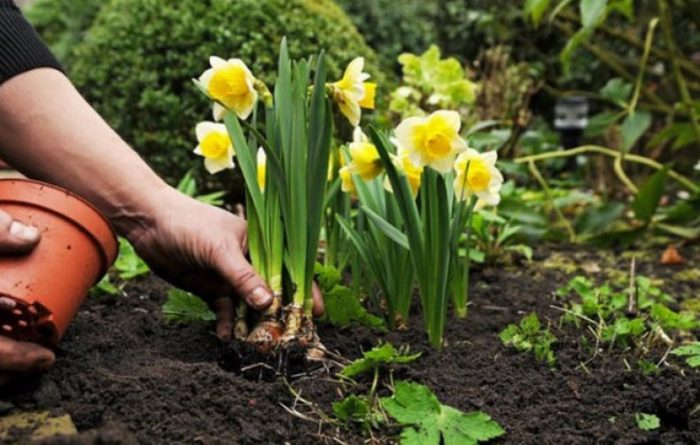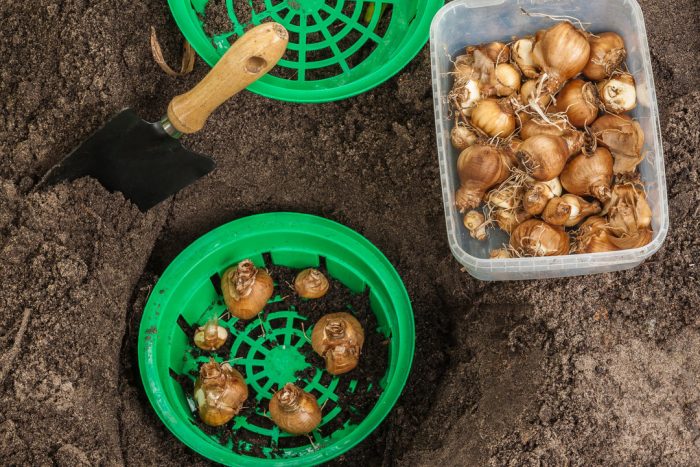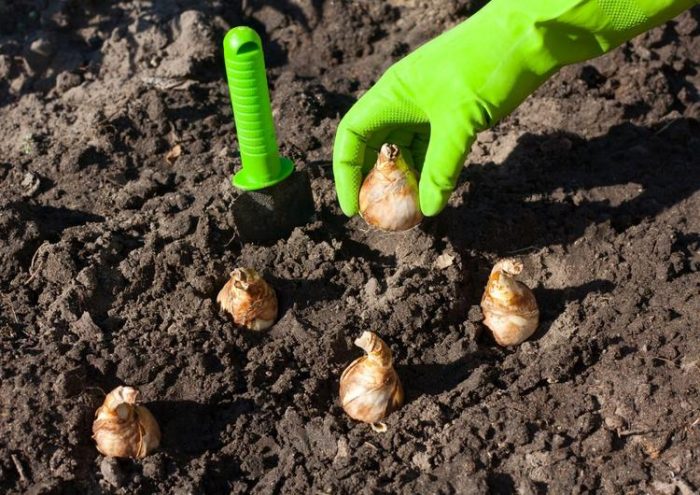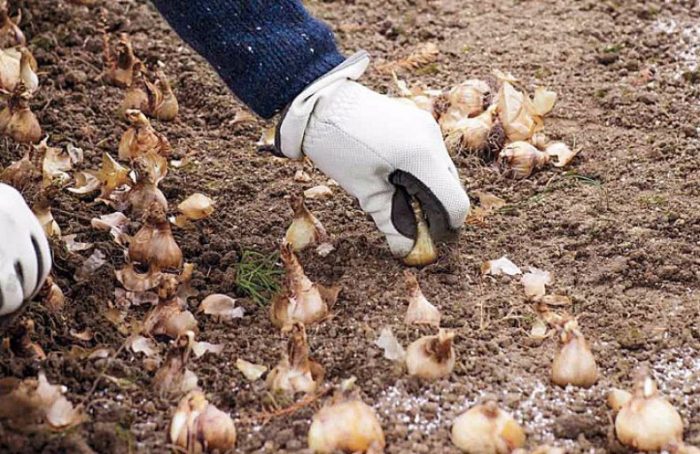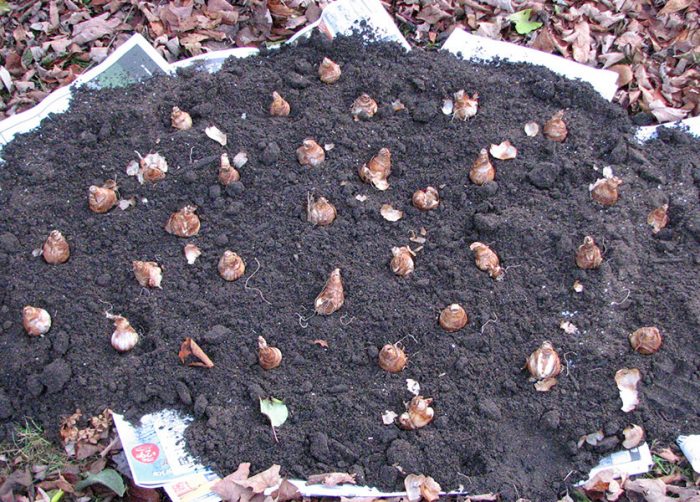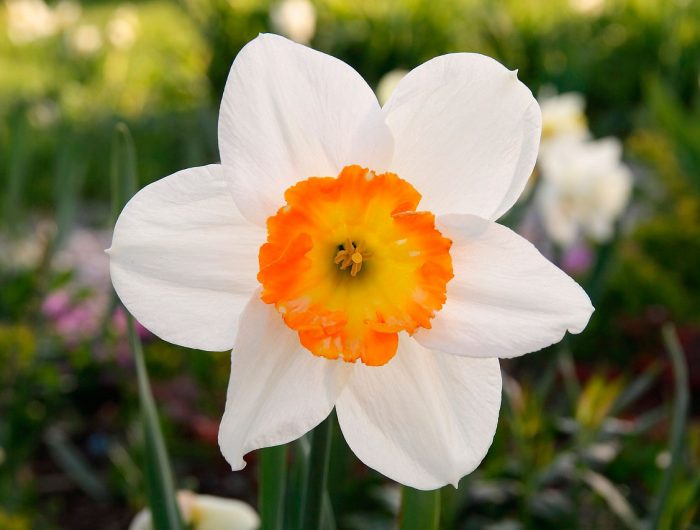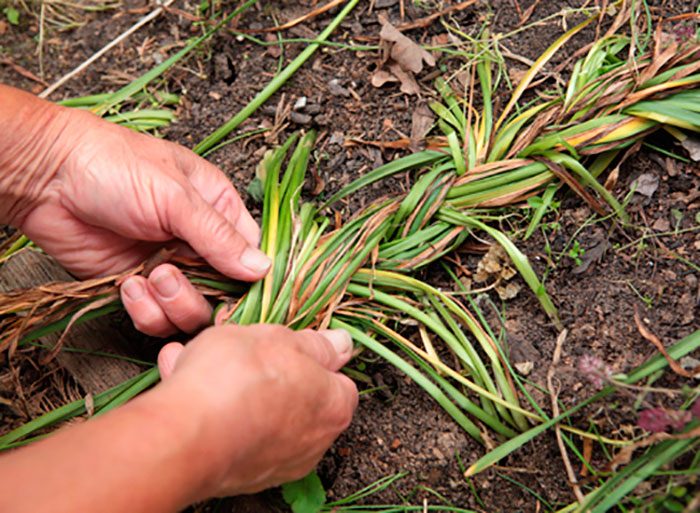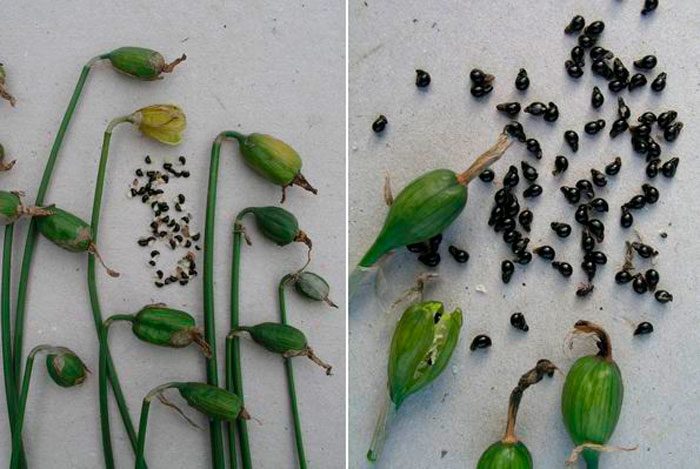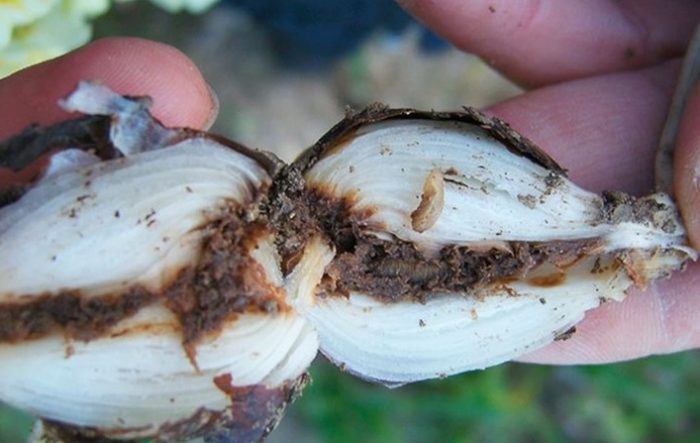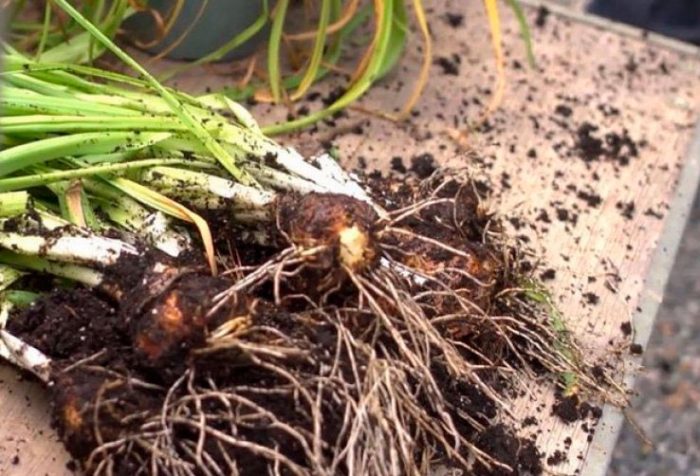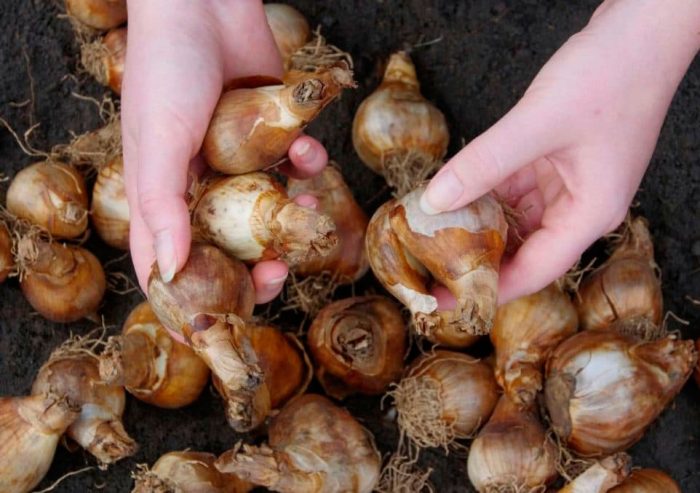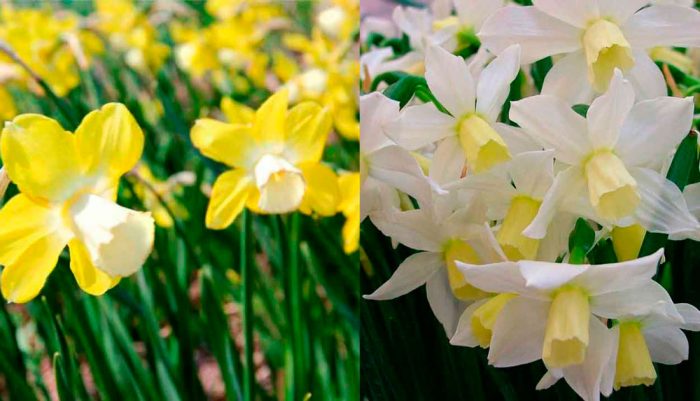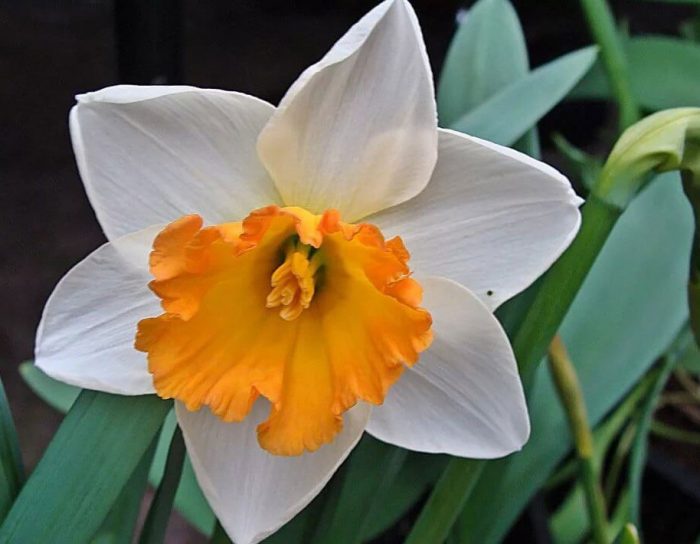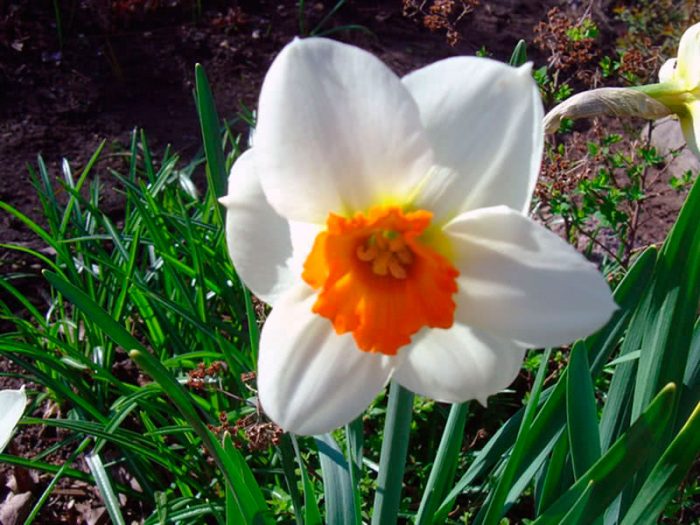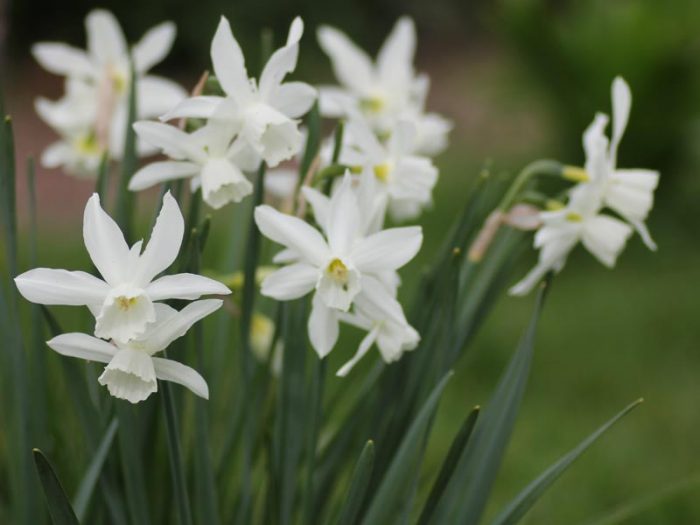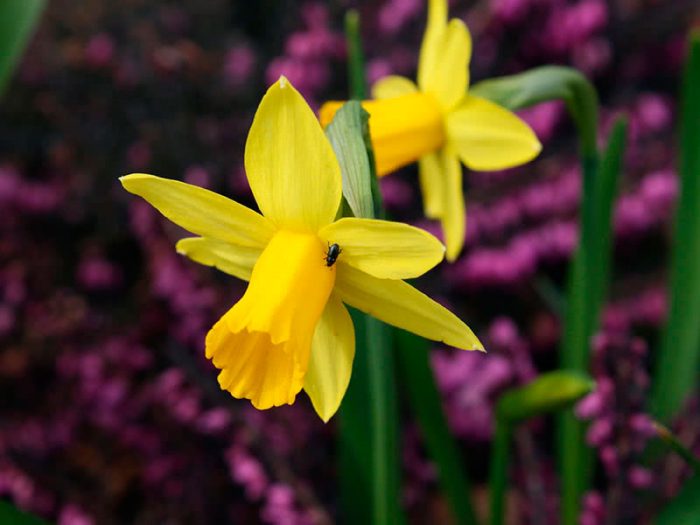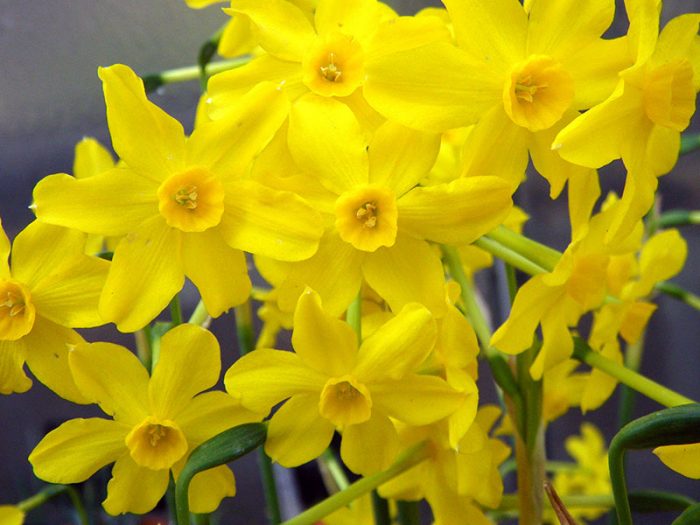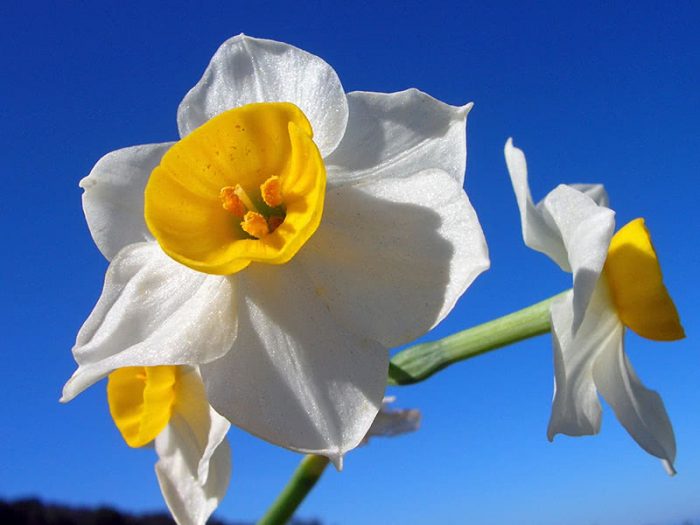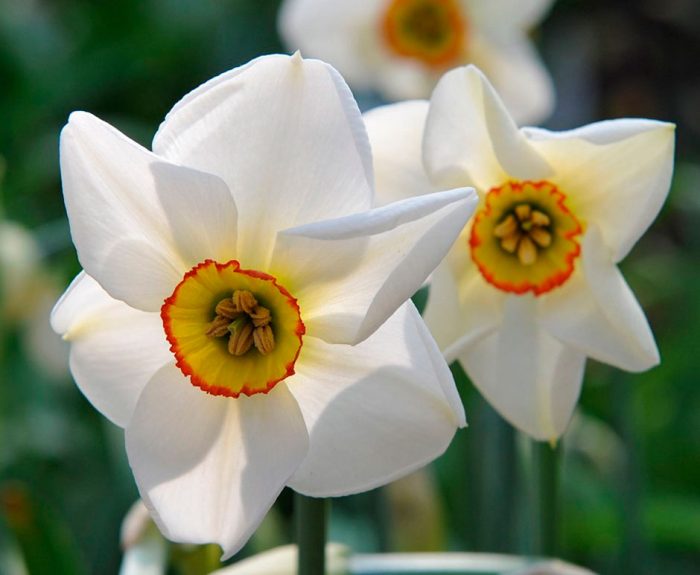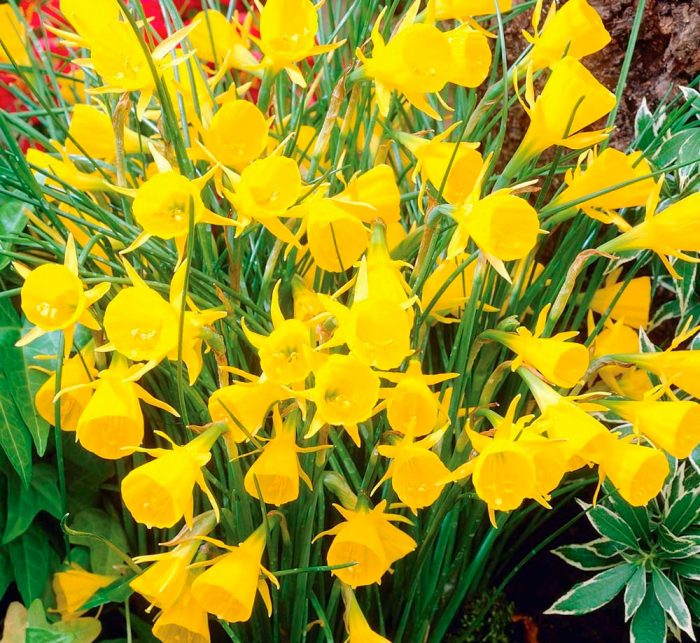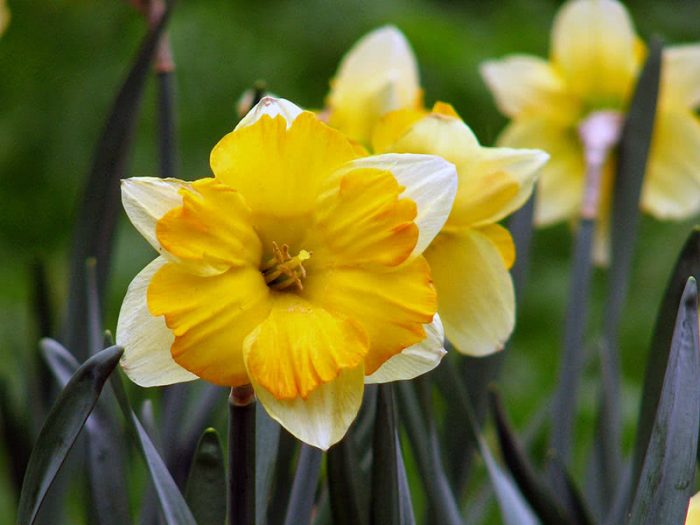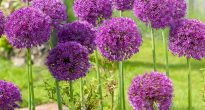The monocotyledonous plant Narcissus (Narcissus) is a member of the Amaryllidaceae family. This spring flower is one of the earliest. The genus includes about 60 species. In nature, the narcissus is most often found in the Mediterranean, southern Europe, and also in Asia. Gardeners cultivate only 25 species of daffodil, and many more hybrids, united under the name "hybrid daffodil".
Since ancient times, man has attributed various unusual qualities and properties to this plant. In the East, he was called "nargiz" and was often compared to the charming eyes of his beloved. In ancient Greece, the narcissus became the personification of death, they removed the deathbed. Moreover, in Europe during the Renaissance, on the contrary, it was a symbol of marriage and love. In Italy today, a bouquet of daffodils as a gift is considered a declaration of love. Since ancient times, daffodils have been widely used in medicine and perfumery. The name of the flower, which is derived from the Greek word "narcao", which translates as "intoxicate", has an analogy with the heady smell that causes migraine, and with the narcotic effect of oil made from narcissus, and with the poisonous properties of bulbs. The alkaloid narcissin is a part of the culture bulbs, which is a reliable protection against rodents. At the end of the nineteenth century, there was the last peak of popularity for daffodils, from that very time the fashion for this plant and its smell does not pass. And today such a flowering plant is massively cultivated in the East for the sake of obtaining essential oil. Among the British, the daffodil is even more popular than the rose, which is considered the "queen of flowers", and in China on New Year's, the presence of these fragrant flowers is mandatory. Well, and "Black Narcissus", probably, everyone watched or read.
Content
Brief description of cultivation
- Landing... In August or in the first days of September.
- Digging... After the foliage turns yellow and light.
- Storage... The bulbs are stored in a well-ventilated room, the temperature in which should be kept at about 17 degrees.
- Bloom... In the springtime.
- Illumination... A shaded and sunny area, as well as one that is in the shade, is suitable for planting.
- Priming... The soil should be nutritious, it should be good for water and air, and be saturated with humus. And its acidity can vary from slightly alkaline to slightly acidic.
- Watering... The narcissus should be watered sparingly but systematically.
- Fertilizer... In spring, after the appearance of the first shoots, it is full complex, during the emergence of the peduncle - with nitrogen-potassium, during the formation of buds - with full complex, and during flowering - with potassium-phosphorus fertilizer. You cannot use manure for feeding.
- Reproduction... Propagated by seeds much less often than bulbs.
- Harmful insects... Ticks, nematodes, onion hoverflies, slugs, daffodil flies.
- Diseases... Fusarium, gray rot, penicillosis, yellow and white viral streaks, ring spot.
- Properties... All parts of the plant contain poison, since they contain the alkaloid narcissin.
The narcissist myth
There are many legends and myths about daffodils. But the most famous of them is the ancient Greek myth, which speaks of a handsome but heartless young man, his name was Narcissus. He did not want to reciprocate the love of the mountain nymph Echo. Desperate, she turned to the Gods for help, and Narcissus was punished by Aphrodite for his coldness, she made him fall in love with her reflection in the stream. From love to himself, he melted before our eyes, until, in the end, he died. Taking pity on him, the gods made it so that in the place where his lifeless body was, a beautiful flower grew, which was named after him a daffodil. Since then, the name "narcissist" has become a household name, there is even such a psychological term as "narcissism", which means exceptional narcissism.
Features of a narcissus
The flowering narcissus plant has dense bulbs and 2–4 ribbon-shaped leaf plates of different widths. Basal leaf plates of a linear shape appear before the peduncle. Leafless stems can be round or flattened, there is a film drag on their surface. At the top of the stem, a flower is formed. Different types of narcissus have different bulb shapes, they can be oval, ovoid, pointed or round. In some species, the bulbs form a nest; on one bottom, several bulbs are formed, which are wrapped in colored scales. Every year, the old roots of the bulbs die off, and new ones grow in their place, the lifespan of the roots is no more than 10 months. Drooping or straight flowers can be part of the umbellate racemose inflorescence in the amount of 2-8 pieces, or be single. The shape of the petal-shaped perianth is a tubular funnel, passing in the upper part into a horizontally located limb. The bridle can have a tubular, bell-shaped or cupped shape; it is formed by outgrowths of the perianth lobes, which are most often painted in a different shade. Flowers can be yellow or white. There are also species and varieties with two-color flowers. In diameter, they can reach 20–100 mm. The fruit is a three-nested capsule with seeds inside. Most often, the bushes reach a height of 0.1 to 0.5 meters. You can decorate your garden with daffodils, and if you wish, you can also grow them at home. Blooming is observed in April – May.
Preparing for landing
Daffodils are primroses. They appear in the garden very early, along with crocuses, hyacinths and tulips.The plant itself is quite unpretentious, but if you do not have enough time to provide the flowers with good care, then it is better not to decorate your site with them. The point is that only if the narcissist is properly cared for can he grow up the way he should be.
Site selection
Particular attention should be paid to the choice of a site where daffodils will grow. It must be absolutely sunny, the soil needs water and air permeable. The culture grows best on neutral loam, into which humus or compost was introduced for digging, please note that manure cannot be used as fertilizer. Too alkaline soil is corrected by adding dolomite flour into it (by 1 m2 plot of 200 grams), while wood ash is introduced into too acidic soil (1 m2 1 tbsp.).
Lilies, tulips and other bulbs, as well as perennial asters, chrysanthemums and phlox are considered to be bad predecessors of daffodils. But the area where legumes, peonies, cereals, nightshades and cucumbers were previously grown is perfect for growing such a flower crop.
Bulbs
Planting bulbs in open soil is carried out after warm weather is established. In spring, most specialty stores sell stale goods very cheaply, so the gardener has the opportunity to purchase bulbs of rare varieties of daffodils for next to nothing. However, when choosing planting material, it must be borne in mind that the bulbs should not be weakened or soft, since there is a high probability that they will not sprout. However, if they do grow up, they will have to provide very good care. The most appropriate time to purchase planting material is 3 months after flowering. Experts advise against buying bulbs:
- in the springtime;
- extracted from the ground with shoots, roots and flowers during the flowering period or immediately after its end;
- multi-peaked, if they have one large onion, and all the rest are small;
- with the emerging sprout.
Before proceeding to planting, it is necessary to inspect the bulbs, while removing all those affected by the disease, excessively soft, with a diseased bottom or injured. The planting material that will pass the selection must be disinfected; for this, it is immersed in a solution of potassium manganese (1%) or a fungicidal preparation (3%) for 30 minutes.
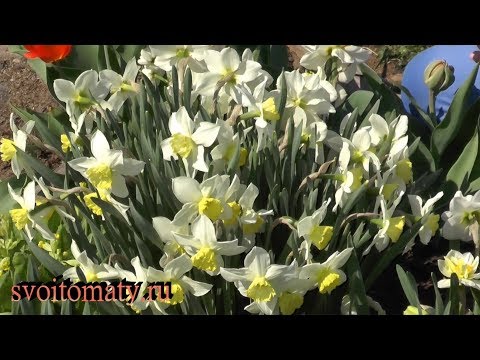

Watch this video on YouTube
Planting daffodils outdoors
What time to plant
The time of planting daffodils in open ground is influenced by the weather conditions of a particular region. Like other bulbous crops, it is recommended to plant daffodils in the garden in the fall. In mid-latitudes, it is best to plant them in September, so that the bulbs take root well, they will need 20 to 30 days. Planting can also be carried out in winter and at the very beginning of spring, but in any case, the bulbs should be prepared before planting. To do this, they are placed on a refrigerator shelf for 60 days, otherwise they will not be able to root normally and will not form flowers.
Bulbs that have been placed in the refrigerator for storage can be planted in open soil in the second half of April, but only if the snow cover has already melted. The daffodils planted at this time root perfectly at an air temperature of 5 to 7 degrees.
Spring planting
Planting is carried out in early spring. But before proceeding with it, it is necessary to prepare a site, for this it is dug up to about the depth of a shovel bayonet and fertilizers are introduced into the soil: humus and nitrophosphate (60 grams per 1 square meter), and also sand. If you failed to prepare the site properly, then planting can still be carried out, but only if the composition of the soil is optimal for growing this crop.
Dig planting holes in the prepared area, the depth of which should be equal to 3 onion diameters.Then a handful of sand, 2 large tablespoons of wood ash are poured into the hole and an onion is placed there. Fill the hole up to half with soil mixed with compost and water well, then fill it to the top with soil and tamp its surface.
The distance between the planting holes depends on whether you will be planting daffodils after 1 year, or they will grow in this area for 5 years. In the event that you decide to seat them, then the distance between the holes should be from 7 to 10 centimeters. If they grow in the same place for 5 years, in this case the distance between the bushes should be from 15 to 20 centimeters. When planting is completed, it is recommended to cover the surface of the soil with a layer of mulch, which can be used as a nutshell, chopped straw, sawdust of hard trees or mown grass. A layer of mulch is able to restrain the growth of weeds, and it also prevents moisture from evaporating from the soil very quickly. Also, mulch is good because the surface of the area covered with it does not need to be loosened after each watering.
Autumn planting
If the planting will be carried out in the fall, then the preparation of the site should be done in the summer. To do this, dig the soil to the depth of the shovel bayonet and add 2 tbsp. l. superphosphate, 4-5 kilograms of peat or compost, and another 1 tbsp. l. "Agricola for flowering plants" per 1 square meter of land. If the soil is excessively heavy, then this can be corrected by adding ½ a bucket of rotted humus and sand per 1 square meter to the soil. Then re-digging is carried out to a depth of 10 to 15 centimeters and the site is left alone until planting. Bulbs are planted and looked after in autumn in the same way as in spring. Remember that autumn is the best time to plant daffodils, which is why experienced gardeners plant in the spring only as a last resort.
If the flower grows in the same place for 4 or 5 years, and it has grown greatly, then you will need to remove it from the soil, separate the children from the bulb and plant them. This is done after the bush has faded. This breeding method is the simplest and most reliable.


Watch this video on YouTube
Daffodil care
Fertilizer
At the very beginning of spring, daffodils should start to grow. Immediately after the emergence of sprouts, daffodils need to be fed for the first time with mineral fertilizer (30 grams per 1 square meter). The second time, the flowers are fed during the formation of buds in the last days of May, while 20 grams of mineral fertilizer are taken per 1 square meter of the plot. In order for the bushes to bloom as luxuriantly and for a long time as possible, the second dressing will need to be repeated after a while. When the flowering is over, the plant must be fed with a mixture of potash and phosphorus fertilizers (1: 2), while for 1 square meter of the plot, from 50 to 60 grams of the nutrient mixture is taken. After applying fertilizer to the soil, it should be watered, and then the surface should be loosened.
Watering
Daffodils are moisture-loving plants, in this regard, they need to be watered regularly and abundantly (20 liters of water are taken per 1 square meter of the plot). When the flowers are watered, do not forget to loosen the surface of the soil and pull out all the weeds, but only if the area is not covered with a layer of mulch. Thus, it is necessary to care for the crop from the moment the sprouts appear until flowering ends.
Post-flowering care
After the bushes have faded, they should be watered and the soil near them should be loosened with the same frequency for another 15–20 days. If you plant various varieties of narcissus on the site, then they can delight you with their flowering throughout the summer. And do not forget that daffodils will be as beautiful as possible only if you feed them on time and take good care of them.Flowers that have begun to wither must be cut off, otherwise the plant will spend a lot of energy on the formation and maturation of seeds, which will negatively affect the growth and development of bulbs.


Watch this video on YouTube
Daffodil transplant
You can understand that daffodils need a transplant by the flowers. If they began to become smaller, and their quality also deteriorated, then most likely they need a transplant, during which the bulbs are divided. The transplant is carried out after the bushes have faded. Do not forget to pre-prepare a new site, for this they dig it up and apply fertilizer to the soil. It is necessary to dig up and carry out the division of daffodils only after their foliage turns yellow and wilts naturally. This can only happen a couple of months after the end of flowering, especially if there are frequent rains. During the growing season, an average of 2–4 new bulbs are formed from one bulb. After the bulbs are removed from the soil, they need to cut off all wilted foliage, and also conduct a thorough examination. Sick and pest-damaged bulbs are discarded. Dead scales are removed from the surface of bulbs suitable for planting, after which they are washed and disinfected for 30 minutes in a strong solution of potassium permanganate. Then they are divided. Tear off all easily separable babies. Those bulbs that come off with difficulty, you need to try to gently loosen, if they still separated with effort, then they process the fracture sites with wood ash or coal powder. Never cut live roots from the bulbs. After that, they are laid out in a shaded place to dry, and then placed in storage. To do this, they are removed to a cool place (no warmer than 17 degrees), while they need to be laid out in such a way that they do not come into contact with each other, in which case their wounds can heal. It is not worth pulling with the planting of the bulbs, from the moment they are removed from the soil to planting, no more than 8 weeks should pass. How to plant daffodils in open ground is described in more detail above.
Reproduction of daffodils
Such a flowering plant can be propagated not only by bulbs and their children. It can also be grown from seeds. For sowing, freshly harvested seed material is used, which has not yet had time to dry out. Seed collection is carried out in the middle of the summer period or in late autumn. You can sow them in boxes or bowls, and, if desired, in open soil. Sowing seeds should not be thick, while the sowing depth should be equal to three diameters of the seed. During the first 1-2 years, experts do not advise diving or replanting seedlings, as they should form a strong, good bulb. When this happens, young flowers are transplanted into open ground to a permanent place. The first flowering of daffodils grown from seeds is observed only after 6-7 years, and small-flowered species - after 3 or 4 years. Note that seed propagation is suitable for growing wild species only. If a hybrid form is grown from seeds, then the seedlings will not be able to retain the varietal characteristics of the parent plant.
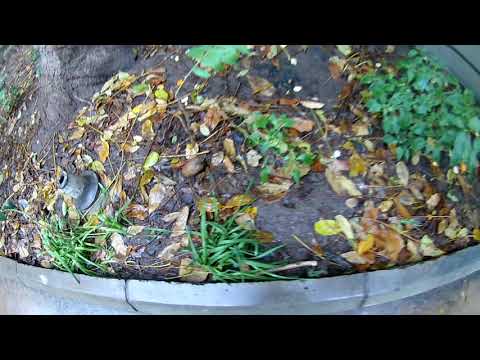

Watch this video on YouTube
Narcissus pests and diseases
The best prevention of the appearance of diseases and pests is compliance with all agrotechnical rules of the culture. However, even in this case, the narcissists can get sick. Most often they suffer from fungal diseases, the symptoms of which are very similar to each other.
The greatest danger to daffodils is Fusarium. At the very beginning, the bottom of the bulb is affected, and then the disease begins to gradually rise up the bush. A pinkish-white bloom forms on the surface of the bulbs, and they themselves soften, the tips of the leaf plates turn yellow, then turn brown and eventually dry out.
In some cases, the culture is affected by gray rot (botrytis), which outwardly looks like a fluffy bloom of gray color with black dots, which forms under the covering leaves of the bulbs. Pale brown specks appear on the foliage, increasing in size, and the buds and shoots rot.
It also happens that the flower is affected by penicillous rot (penicillosis), as a result, no shoots appear from the bulbs in spring. The development of the disease occurs due to very high humidity.
In order to prevent fungal diseases, immediately before planting, the onions must be immersed in Maxim's solution for 30 minutes. At the very beginning of the growing season, the sprouts that appear are treated with a solution of Bordeaux mixture (1.5%).
Viral diseases can also affect the culture, for example: yellow or white striping, mosaic virus, ring spot, etc. The signs of all viral diseases are very similar to each other: the development of flowers deteriorates, the bulbs become smaller, spots appear, streaks and streaks of various colors. Daffodils can be infected with a viral disease through pests, soil, pollen, seeds, or garden tools. Because of this, it is very difficult to fight such dangerous diseases, the fact is that today they are considered incurable. Preventive measures:
- For planting in open soil, it is recommended to use only absolutely healthy and large bulbs, which must be disinfected beforehand. Small bulbs get sick much faster.
- It is necessary to start in a timely manner the fight against pests, which are the main carriers of viruses, namely, with beetles, ticks, leafhoppers, whiteflies and nematodes.
- Dig up and burn diseased bushes in time to prevent the spread of the disease.
Most often, bears, root mites, nematodes, slugs and narcissus flies settle on the flower. In order to prevent the appearance of a daffodil fly and a nematode, immediately before planting, the bulbs are heated in hot water for several hours (43.5 degrees). If a daffodil fly has settled on a bush, then it is treated with a solution of fufanon (2%), the nematode is fought with drugs such as carbation and nemaphos. During the formation of buds, the bushes are treated with Fitoverm solution (for 10 liters of water, 20 milligrams), while 1 liter of the mixture is used to spray 10 square meters of plantings.
Daffodils after flowering
Wintering features
Narcissus has a fairly high resistance to frost. However, if the winter is with little snow and very frosty, then the bulbs wintering in the soil may freeze. Most of all, thaws can harm such bulbs, since during warming they wake up and begin to grow, and the returned frosts destroy the flowers. If daffodils are in the soil in winter when the foliage is completely wither and wither away, the surface of the site must be carefully loosened. Then it must be covered with a layer of mulch (loose leaves, peat, wood ash or straw), the thickness of which should be 10-15 centimeters. Instead, it can be covered with a special covering material, for example: spunbond or agrospan. It is necessary to fill up the plot with mulch only after the soil slightly freezes in the autumn. And you need to remove the mulching layer only after the spring return frosts are left behind.
What time to dig the bulbs
If the bulbs are stored in a cool room in winter, then they should be removed from the soil immediately after all the leaves turn yellow in June or July, and their tips dry out, while the compact bush should begin to fall apart. From the moment of the end of flowering until the time when the bulbs can be dug, sometimes it takes about 8 weeks (it all depends on the temperature and humidity).
It is also not recommended to tighten it when digging out the bulbs, because the dried leaves may fall off, and you will not find the place where the bush was.Use a small garden fork to remove the daffodils from the ground. You need to cut off the foliage from the dug out bulbs, and then they are laid to dry in a shaded place. After they dry out, and the remains of the soil fly around them, carefully separate the daughter bulbs from the mother, while trying not to injure the roots. Inspect the bulbs and remove any deformed, diseased and soft bulbs, it is recommended to destroy them. The selected planting material is washed under running water, and then it is disinfected, for this it is placed for 10-15 minutes. into a solution of potassium permanganate of dark pink color. Then it is removed to a dry, shaded and warm (22 to 25 degrees) place to dry. If you put it indoors, then it must have good ventilation.
Storage features
Bulbs should not be stored in a plastic bag, as it does not allow them to "breathe" normally, as a result of which their centers begin to rot. For storage, they are removed in a well-ventilated and cool place. It should be borne in mind that during storage, the planting material emits gas, and if a lot of it accumulates, then the bulbs may suffocate.
They will be perfectly stored in a shaded, well-ventilated room, while the air humidity should be about 70 percent, and the temperature should be from 10 to 12 degrees. Place the bulbs in a thin layer on a pallet or wood trellis box. During the winter, carry out regular inspection of the planting material (at least once every 7 days). If you see soft or diseased bulbs, then they are removed and destroyed. If spots of yellow or white color are formed on the surface of the skin of the bulbs, this means that rot has appeared on them, and their darkening is a sign of a fungal disease. Bulbs affected by bacterial rot have an unpleasant odor.
Types and varieties of daffodils with photos and names
Numerous varieties of daffodils are registered by the Royal Horticultural Society. He combined all garden forms of daffodils under the general name Narcissus hybridus into 13 groups, 12 of which systematize garden daffodils, and one - natural forms and types of such a flower. Below will be a brief description of garden daffodils.
Tubular daffodils (Trumpet)
This group has 1 large flower on the peduncle, the length of the tube and perianth lobes are the same, in some cases the tube is slightly longer. The color of the flowers is two-colored, but most often it is white or yellow. Such varieties reproduce very well, their bulbs reach 50 mm or more in diameter.
Gin and Lime - lemon-colored perianth and crown. The crown gradually changes its color to white with a green eye.
Large-cupped
This daffodil is solitary. The flower crown can be corrugated or smooth, its length is slightly more than 1/3 of the length of the petals. The color can be very different, in some cases the crown is decorated with a rim of a rich shade. The duration and timing of flowering, as well as the length of the peduncle, differ in different varieties. Compared to tubular daffodils, large-crowned bulbs are smaller.
Jeanine - the color of the perianth is snow-white, and the crowns are deep pink.
Small-cupped
This daffodil is also solitary. The crown length does not exceed 1/3 of the petal length. Medium-sized flowers with a delicate aroma are usually whitish-cream colored. Such varieties bloom magnificently.
A very beautiful variety is Sabine Hay - a not very large flower adorns an orange perianth and a deep red crown. Differs in late flowering.
Terry (Double)
This group is highly decorative. On a peduncle, these varieties can have either one flower or several. Only the crown or the whole flower can be terry.The shape, color and size of flowers can be different, since those varieties were selected for this group that corresponded to the only principle - terry.
Tahiti variety - this variety has been in a private collection for a long time, and the world learned about it relatively recently. The size of the flower is about 80–100 mm. The deep yellow perianth lobes in the middle are connected to the scallops of the orange-red crown. This variety differs in that it gradually fades in the sun.
Triandrus
This group includes low-growing varieties, the height of the bushes in which is about 0.25 meters. On one peduncle, 2-3 flowers with a small crown and slightly bent petals are formed.
Ice Wings - a spectacular flower with a very large crown and snow-white petals. Flowering is long.
Cyclamineus (Cyclamineus)
The group contains varieties obtained as a result of crossing the cyclamen narcissus with cultural and species forms. Most often, the flowers are single, outwardly similar to cyclamen - the petals are bent back. A thin long crown is in some cases even longer than the petals. Blooms very early.
Cotinga - the color of the petals is snow-white, and the crowns are apricot-pink. Early-middle flowering.
Jonquilla
The group includes varieties created by breeders using the species daffodil Jonquille. Blooming later. The color of the leaf plates is dark green, and several flowers are formed on one peduncle. The length of the cup-shaped crown does not exceed 2/3 of the length of the perianth. A flower can be grown in the same place without transplanting for 5 to 7 years.
Suzy - medium flowering. The perianth is golden yellow, and the crown is orange-red.
Multi-flowered, or tacetate (Tazetta, Bunch-flowered)
The varieties of this group are frost-resistant. A racemose inflorescence is formed on the peduncle, which includes 2–20 fragrant flowers. The shape of the perianth lobes is rounded, the crown is not very large. The foliage is dark green.
Hugh Town cultivar - the yellow flower has a spectacular orange crown with a graceful shape.
Poetic (Poeticus)
Only one white flower is formed on the peduncle, its crown is small (about 1/3 of the perianth length) and bright. The perianths are colored milky white. The bulbs are very small. The size, flowering period and shape depend entirely on the variety.
The Actaea cultivar is a perfectly shaped flower with a yellow crown with a green eye and a red rim.
Bulbocodium Hybrids
This group includes daffodils with small bell-shaped flowers. Today Australian breeders are busy developing new varieties. There are varieties with white flowers.
Split-Corona
The fringed crown of the flowers seems to be torn, their petals are also fringed. This group is divided into 2 subgroups:
- Split crown... The segments of the crown, as well as the perianth lobes, are located opposite each other.
- Papillon... The flower is similar in structure to a butterfly.
Palmares cultivar - pinkish-white flowers have a slightly compressed crown cut. Average flowering, prefers bright lighting.
Others
This group includes those varieties that, according to their characteristics, cannot be attributed to any of the groups.
All species
This group includes only species daffodils, as well as their hybrids.
Sort "Odorus Plenus" - spectacular double flowers have a pleasant aroma, it is distinguished by medium-late flowering.
Of all the varieties, pink daffodil stands out. Such a plant with a pink crown appeared in England in 1921 thanks to the efforts of R.O. Backhouse. It has been used to breed many varieties belonging to different classes, for example: tubular, Jonquillia, terry, cyclamen, etc. However, they are still called pink.
Foundling is a cyclamen-shaped daffodil with snow-white petals and a deep pink crown.This variety has won numerous international awards.
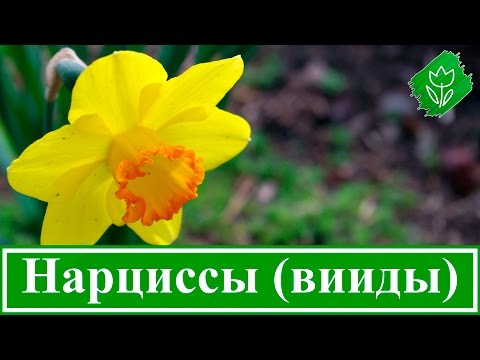

Watch this video on YouTube
Healing properties
Narcissus bulbs in oriental medicine were used for mastitis. For this, the peeled onion was crushed, and the resulting mass was combined with thick rice porridge or rye flour. The resulting mixture was smeared with a sore chest. After complete drying, the product was removed with warm water. They smeared the breast with the remedy twice or three times a day, and it helped quite well, but only if the woman did not have an allergy to the substances that make up the bulbs. To understand whether such a remedy is suitable for a particular patient, it was possible empirically. If, after using it, there was hives or redness of the skin, as well as itching, then it was considered that this remedy was not suitable for treatment.

